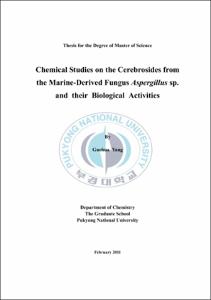Chemical Studies on the Cerebrosides from the Marine-Derived Fungus Aspergillus sp. and their Biological Activities
- Alternative Title
- 해양균류 Aspergillus sp.에서 분리된 Cerebrosides의 화학적 연구와 생물활성
- Abstract
- Abstract
Marine derived fungi have been a rich source of structurally novel and pharmacologically active secondary metabolites.
With the aim to search for new bioactive compounds, we have focused on our attention to marine-derived fungi. The secondary metabolites were obtained from combining the modern knowlwdge of microorganism and chemical techniques in culture, extraction, isolation, and prification. The total structure of secondary metabolites and thir biological activities have been investigated and the
results are as follows:
1. Cerebroside C (1) was isolated from mycelium extract of the marine-derived fungus Aspergillus sp. (MFA500). The structure and absolute stereochemistry of the coumpound were assigned by specytoscopic methods. The data from FAB-MS indicated the molecular formula of the compound as C43H81NO9. Compound 1 exhibited 3-(4,5-Dimethylthiazol-2-yl)-2,5-diphenyltetrazolium bromide (MTT) activity with IC50 valule of 45.6 μM.
Cerebroside C (1)
2. The same fraction of Aspergillus sp. (MF500) yielded a metabolite, cerebroside D (2). The data from FAB-MS indicated the molecular formula of the compound as C43H79NO9. The molecular structure of cerebroside D (2) has been elucidated by 1D and 2D NMR data analysis including COSY, HMQC and HMBC. Cerebroside D (2) exhibited 3-(4,5-Dimethylthiazol-2-yl)-2,5-diphenyltetrazolium bromide (MTT) activity with IC50 valules of 47.6 μM.
Cerebroside D (2)
- Issued Date
- 2011
- Awarded Date
- 2011. 2
- Type
- Dissertation
- Publisher
- Pukyong National University
- Department
- 대학원 화학과
- Advisor
- Byeng Wha Son
- Table Of Contents
- Part I. Introduction 1
Part II. Experimental 3
1. Instruments and chemical reagents 3
1) Instruments 3
2) Chemical reagents 3
2. Isolation of the marine-derived fungus Aspergillus sp 3
3. Culture of Aspergillus sp. and extraction 4
4. Isolation of Cerebrosides C and D 5
1) Cerebroside C (1) 6
2) Cerebroside D (2) 7
5. Bioactive assay 8
1) 3-(4,5-Dimethylthiazol-2-yl)-2,5-diphenyltetrazolium bromide (MTT) assay 8
2) Free radical scavenging assay 9
3) Antimicrobial assay against Staphylococcus aureus, methicillin-resisitant S. aureu and multidrug-resistant S. aureus 9
4) Tyrosinase inhibitory assay 10
5) Acetylcholinesterase inhibitory assay 11
Part III. Results and Discussion 12
1. Structural elucidation of cerebrosides C (1) and D (2) 12
1) Cerebroside C (1) 12
2) Cerebroside D (2) 25
2. Biological activity of cerebrosides C (1) and D (2) 38
1)3-(4,5-Dimethylthiazol-2-yl)-2,5-diphenyltetrazolium bromide (MTT) activity 38
2)Free radical scavenging activity 39
3)Antimicrobial activity against Staphylococcus aureus, methicillin-resisitant S. aureu and multidrug-resistant S. aureus 39
4)Tyrosinase inhibitory activity 39
5)Acetylcholinesterase Inhibitory Activity 39
Part IV. Conclusion 40
Part V. References 41
Abstract in Korean 44
Acknowledgements 46
- Degree
- Master
- Files in This Item:
-
-
Download
 Chemical Studies on the Cerebrosides from the Marine-Derived Fungus Aspergillus sp. and their Biolog.pdf
기타 데이터 / 6.98 MB / Adobe PDF
Chemical Studies on the Cerebrosides from the Marine-Derived Fungus Aspergillus sp. and their Biolog.pdf
기타 데이터 / 6.98 MB / Adobe PDF
-
Items in Repository are protected by copyright, with all rights reserved, unless otherwise indicated.